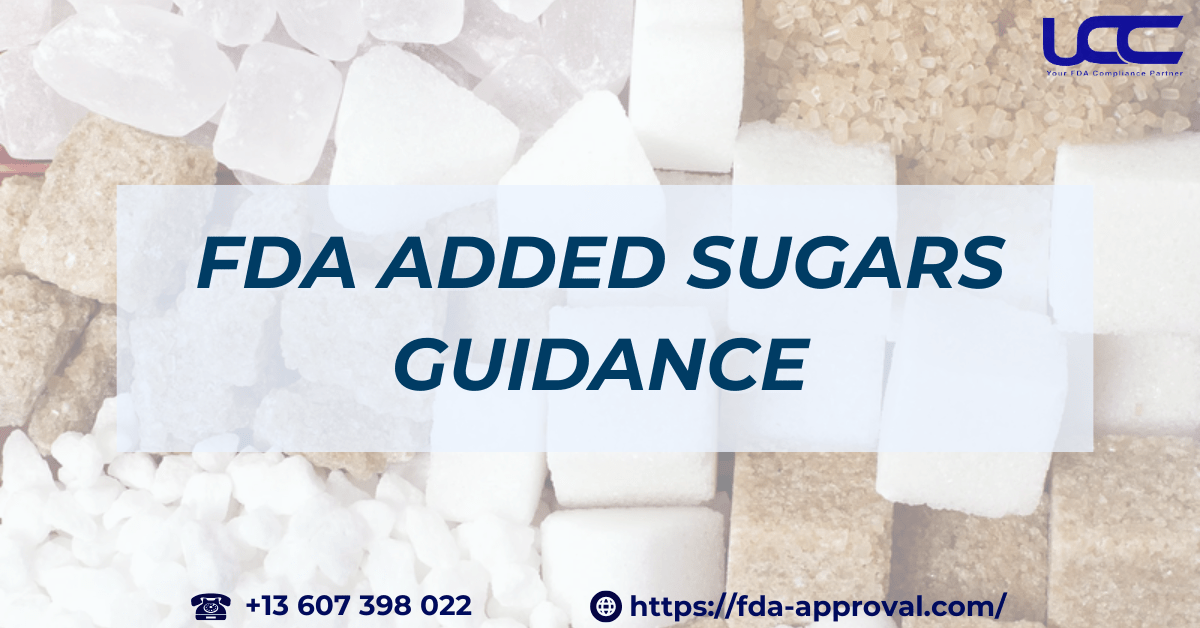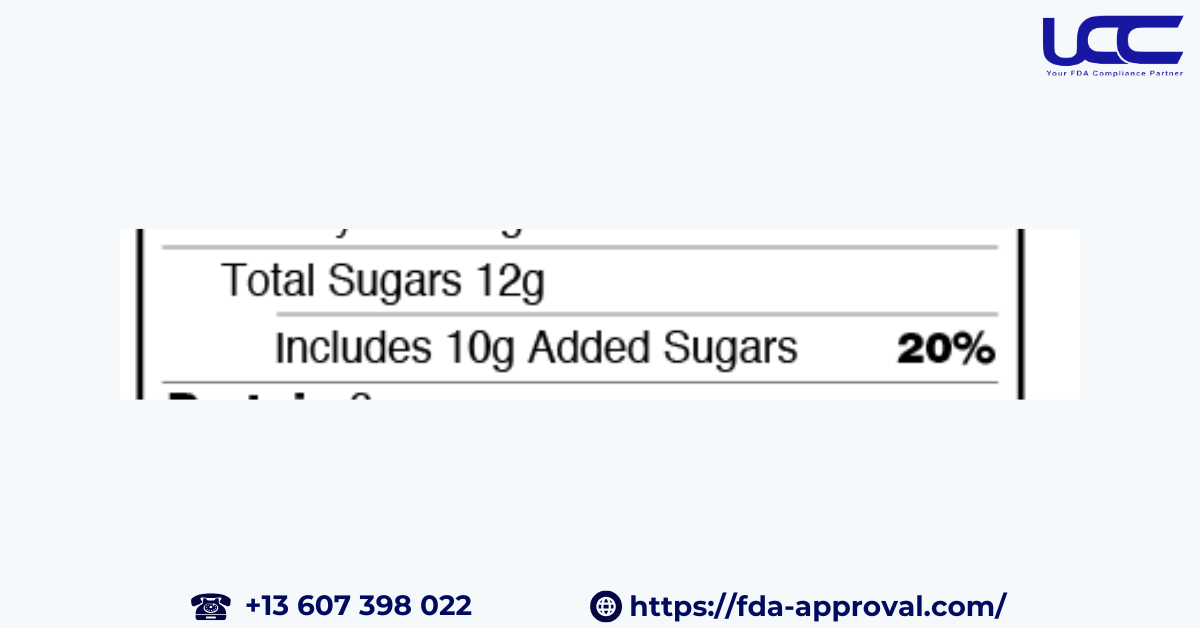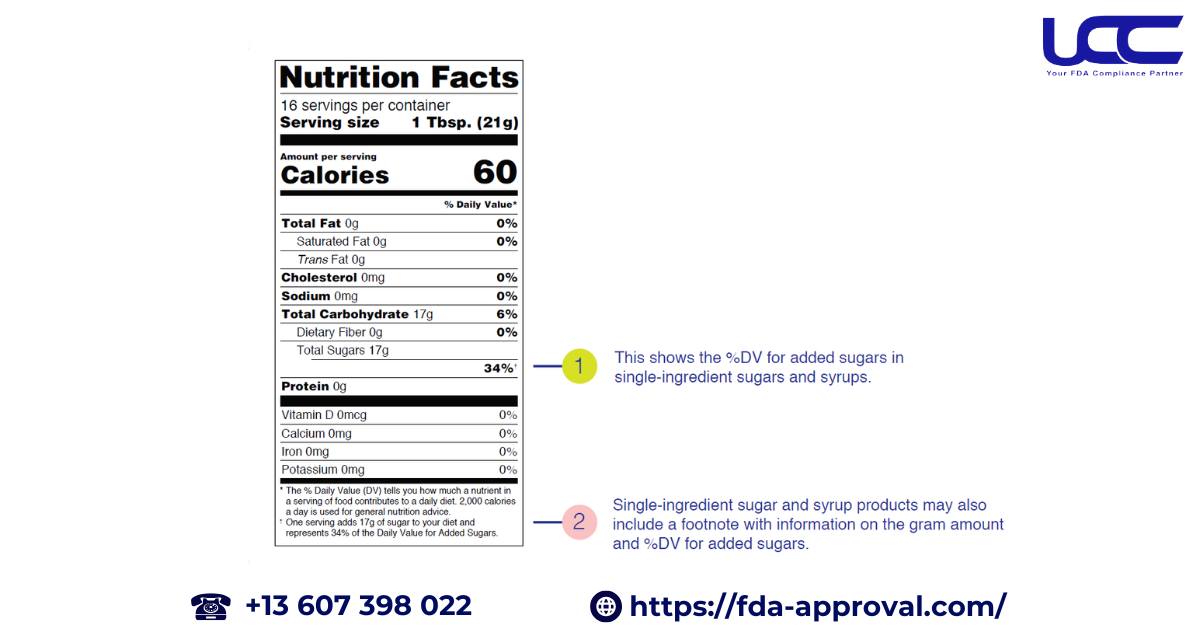In 2020, the FDA updated the Nutrition Facts label for packaged foods, incorporating a new design and reflecting the latest scientific information. These changes aim to assist consumers in making informed food choices that support a healthy diet and help prevent chronic diseases. Notably, one of the significant updates was the inclusion of Added Sugars. In this article, UCC will present the latest FDA added sugars guidance.

1. What Are Added Sugars?
Added sugars refer to sugars that are incorporated during food processing (such as sucrose or dextrose), sweeteners in packaged foods (like granulated sugar), and sugars from syrups, honey, and concentrated fruit or vegetable juices, as outlined in the FDA added sugars guidance. These sugars do not include natural sugars found in milk, fruits, and vegetables. The recommended daily value for added sugars is 50 grams, based on a 2,000-calorie daily diet.
For most Americans, the main sources of added sugars come from sugary drinks, candies, desserts, and snacks.
Note: Distinguishing Between Total Sugars and Added Sugars
Total sugars include both naturally occurring sugars found in many nutrient-dense foods and beverages, such as those in milk and fruit, as well as any added sugars present in the product. There is no Daily Value (DV) established for total sugars, as there are no specific recommendations for an overall sugar intake.
2. Listing Added Sugars on Nutrition Labels – FDA Guidance
2.1. Why is it Important to List Added Sugars?
The U.S. Dietary Guidelines recommend restricting added sugars to less than 10% of total daily calorie intake. The reason for this is that excessive added sugar intake can negatively impact health. Too much added sugar can increase the risk of chronic diseases like obesity, type 2 diabetes, heart disease, and oral health problems. Additionally, when added sugars are too high, meeting nutritional needs for essential vitamins, minerals, and fiber while staying within calorie limits becomes difficult.

Therefore, displaying added sugars clearly on nutrition labels, as per the FDA added sugars guidance, helps consumers make informed choices based on their needs and preferences. It also contributes to maintaining a balanced and healthy diet.
2.2. FDA Guidelines for Displaying Added Sugars
Food and beverage labels containing added sugars will list the amount of added sugars in grams, along with the percentage of the Daily Value (%DV) for added sugars in the Nutrition Facts panel.
When the word “includes” appears before “added sugars,” it means the product contains added sugars within the total sugar amount. In other words, both natural and added sugars are counted as part of the total sugar amount.
For example, if a product’s label shows:

- Total sugars: 12 grams
- Added sugars: 10 grams
This means that 2 grams of the sugars are natural, and the remaining 10 grams are added sugars. The 10 grams of added sugars make up 20% of the recommended Daily Value for added sugars, based on a 2,000-calorie daily diet. The FDA recommends no more than 50 grams of added sugars per day, so this product contributes significantly to that limit.
3. Important Notes on FDA Added Sugars Guidance
3.1. Notes for Added Sugars on Sugar Products According to FDA Guidance
For single-ingredient sugar products like granulated sugar, honey, or syrup, the Nutrition Facts label will list total sugars (both natural and added sugars) with the grams per serving, in accordance with the FDA added sugars guidance. However, the Added Sugars section will only show the percentage of the Daily Value (%DV) for the added sugars. To clarify this, a “†” symbol may be placed next to the %DV, guiding consumers to an explanatory statement about the grams of added sugars in the serving and how they contribute to the %DV.

For example, a product containing 10 grams of added sugars might have a statement like: “One serving adds 10g of sugar to your diet and contributes 20% of the Daily Value for Added Sugars.”
This is particularly important for cranberry products. Due to the fruit’s naturally tart flavor and low natural sugar content, manufacturers often add sugar to enhance taste. However, the total sugar content of the product may still be similar to that of other fruit products that do not contain added sugars. Labels on such products may explain that manufacturers add sugar to offset the natural tartness of cranberries. They may also highlight that, according to the U.S. Dietary Guidelines, small amounts of added sugars can be included from nutrient-dense foods like tart fruits.
3.2. Check Labels to See If the Product Contains Low or High Added Sugars
- 5% DV or less: Considered low in added sugars
- 20% DV or more: Considered high in added sugars
3.3. Should You Eliminate Added Sugars Completely?
The U.S. Dietary Guidelines advise limiting added sugars as part of a healthy diet, allowing for moderate consumption. However, it’s essential to also incorporate foods from the main nutrient groups in MyPlate, such as vegetables, fruits, grains, dairy, and protein-rich foods.

It is crucial to remember that information about added sugars is just one part of a product’s Nutrition Facts label. To make informed food decisions, carefully read all label information, including the ingredient list and other nutritional values. This helps you understand added sugars and other components, allowing you to make choices that support your health goals. By following the FDA added sugars guidance, consumers can better manage their added sugar intake and make healthier food choices.
For more information: How to Register FDA Food Facility: A Step-by-Step Guide
We hope this article has provided you with a clear understanding of the basics of the FDA added sugars guidance. Be sure to stay tuned for our upcoming articles from UCC, where we will share the latest FDA standards!



